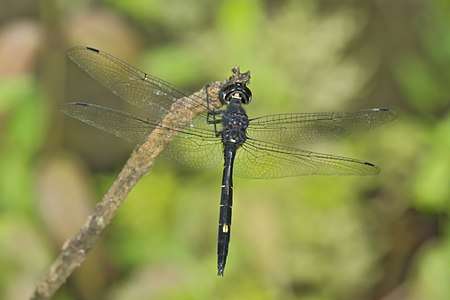Zygonyx iris
The emerald cascader[2] or iridescent stream glider[3] (Zygonyx iris)[4] is a species of dragonfly in the family Libellulidae. It is widespread in many Asian countries.[5][1][6]
| Emerald Cascader | |
|---|---|
 | |
| Zygonyx iris | |
| Scientific classification | |
| Kingdom: | |
| Phylum: | |
| Class: | |
| Order: | |
| Family: | |
| Genus: | |
| Species: | Z. iris |
| Binomial name | |
| Zygonyx iris Kirby, 1900 | |
Subspecies
A number of subspecies of Zygonyx iris have been described, but it is not clear if these merely represent extremes of geographical variation or genuine subspecies.[1][3]
- Zygonyx iris ceylonicus (Kirby, 1905)
- Zygonyx iris davina Fraser, 1926
- Zygonyx iris errans Lieftinck, 1953
- Zygonyx iris insignis (Kirby 1900)
- Zygonyx iris intermedia Lahiri 1987
- Zygonyx iris iris Selys, 1869
- Zygonyx iris isa Fraser, 1926
- Zygonyx iris malabaricus Fraser, 1926
- Zygonyx iris malayanus (Laidlaw, 1902)
- Zygonyx iris metallicus Fraser, 1931
- Zygonyx iris mildredae Fraser, 1926
- Zygonyx iris osiris Fraser, 1936
Description and habitat
It is a dark mettalic blue dragonfly with brown eyes. Its thorax has broad humeral stripe in yellow. Its abdomen is black with sides of segments 1 to 3 broadly yellow. There is an yellow mid-dorsal carina from segments 1 to 6. There is a big yellow spot on segment 7. Female is similar to the male.[7]
It breeds in the swift rocky streams. Larva are adapted to cling on rocks. Females lay eggs in first order streams during summer. Apparently, the larva migrates to second or third order streams during their late instars from where they emerge.[8][7][9][3][2] Males commonly found flying over brooks and streams. They tirelessly fly back and forth across a beat along a hill stream and rarely perch. Sometimes, pairs in tandem can be seen flying above torrents; the female dipping her abdomen periodically to lay eggs[8][7][3]
References
- Sharma, G. (2010). "Zygonyx iris". IUCN Red List of Threatened Species. 2010: e.T167082A6297947. doi:10.2305/IUCN.UK.2010-4.RLTS.T167082A6297947.en.
- "Zygonyx iris Selys, 1869". Odonata of India, v. 1.00. Indian Foundation for Butterflies. Retrieved 2017-02-18.
- "Zygonyx iris Selys, 1869". India Biodiversity Portal. Retrieved 2017-02-18.
- Martin Schorr; Dennis Paulson. "World Odonata List". University of Puget Sound. Retrieved 12 Oct 2018.
- Odonata: Catalogue of the Odonata of the World. Tol J. van , 2008-08-01
- K.A., Subramanian; K.G., Emiliyamma; R., Babu; C., Radhakrishnan; S.S., Talmale (2018). Atlas of Odonata (Insecta) of the Western Ghats, India. Zoological Survey of India. pp. 399–400. ISBN 9788181714954.
- C FC Lt. Fraser (1936). The Fauna of British India, including Ceylon and Burma, Odonata Vol. III. Red Lion Court, Fleet Street, London: Taylor and Francis. pp. 394-396.
- Subramanian, K. A. (2005). Dragonflies and Damselflies of Peninsular India (PDF).
- C FC Lt. Fraser (1924). A Survey of the Odonate (Dragonfly) Fauna of Western India and Descriptions of Thirty New Species (PDF). pp. 441–442.
See also
- List of odonates of Sri Lanka
- List of odonates of India
- List of odonata of Kerala
External links
![]()
![]()
